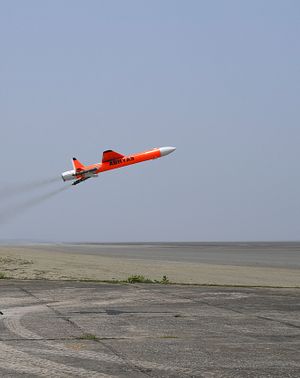On Monday, India’s Defense Research and Development Organization (DRDO) announced that it had successfully tested the Abhyas High-speed Expendable Aerial Target (HEAT) drone. The pilotless aircraft, designed to serve as a target in live-fire weapons tests, was flight-tested at India’s Interim Test Range near Chandipur, Odisha.
“The flight test was tracked by various radars & electro optic systems and proved its performance in fully autonomous way point navigation mode,” a DRDO press release noted.
Abhyas “is designed on an in-line small gas turbine engine and uses indigenously developed MEMS based navigation system for its navigation and guidance,” it added. Monday’s test was successful, according to DRDO.
“The performance of the system was as per simulations carried out and demonstrated the capability of Abhyas to meet the mission requirement for a cost effective HEAT.”
Target missiles and drones serve an important role in the development of a range of interceptors, including surface-to-air systems as well as cruise and ballistic missile defense systems. Abhyas is designed to simulate aircraft for endoatmospheric surface-to-air interception tests as well as air-to-air exercises.
The Abhyas has been in development since 2012 and has been displayed by DRDO at international defense expositions since at least 2013. That year, the Abhyas was displayed at the International Aerospace and Defense Exhibition ADEX-2013 in Seoul, South Korea.
The Abhyas is reported to feature an adjustable simulated radar cross section for live-fire exercises and other drills through the use of a lunberg lens in the nose cone, which improves the target’s radar reflectiveness.
Speaking to the New Indian Express in 2013, P.S. Krishnan, director of DRDO’s Aeronautical Development Establishment, said that the Abhyas was an evolution of an older Indian target drone, the Lakshya.
“We have sized the wings and tail plane in proportionate to that of Lakshya so that we are able to get the final product at the earliest. We have conceived a launcher and also identified two 68-mm rockets for Abhyas. The first experimental flight successfully demonstrated the launch and configuration capabilities,” Krishnan said at the time.
“In addition to being a stable vehicle for weapon practice, Abhyas can be used as an effective jammer platform. Every bit of onboard systems come for Indian industries, which makes Project Abhyas special in many ways,” Krishnan added.
The target drone likely also features sensors, including acoustic missile distance indicators, to allow DRDO engineers to gather information on live-fire tests.
India has a diverse set of indigenous and imported air and missile defense technologies, including the Russian S-400 surface-to-air missile system and the indigenous Akash system.
New Delhi is expected to take delivery of the Russian S-400 surface-to-air missile system by October 2020.

































